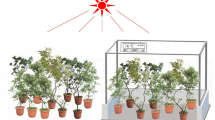Abstract
The relationship between soil redox state, sulphide concentration, salinity and spatial patterns of mangrove species distribution was investigated in the mangrove forest of Gazi Bay (Kenya). Field measurements were conducted to examine the relationship between species distribution along a band transect of 280 m and soil redox potential (Eh) and sulphide patterns, as well as the indirectly related (through flooding regimes) soil salinity. Of the three major species Avicenniamarina, Ceriops tagal and Rhizophoramucronata present along the transect, only the distribution of the latter correlated with the measured soil variables, R. mucronata being absent from the less‐reduced zone with high salinity. Bruguieragymnorhiza and Heritieralittoralis occur in minor populations, they are restricted to the saline, sulphide‐poor and less‐reduced substrates. From the results it is concluded that soil redox potential (Eh), sulphide concentration and salinity may contribute to structure mangroves through the distribution of dominant species, however in combination with other environmental conditions and processes of vegetation dynamics.
Similar content being viewed by others
References
Ball, M.C. 1980. Patterns of secondary succession in a mangrove forest of southern Florida. Oecologia 44: 226–235.
Beeckman, H., Gallin, E. and Coppejans, E. 1990. Indirect gradient analysis of the mangal formation of Gazi Bay (Kenya). Silva Gandavensis 54: 57–72.
Brakel, W.H. 1982. Tidal patterns on the East African coast and their implications for the littoral biota. Proceedings of the Symposium on the Coastal and Marine Environment of the Red Sea, Gulf of Aden and Tropical Western Indian Ocean 2: 403–418.
Chapman, V.J. 1976. Mangrove vegetation. Journal of Cramer Verlag, Vaduz.
Dahdouh-Guebas, F. 1994. Kenyaanse Mangrovekrabben: voedingsecologie en gedragsecologie van enkele geselecteerde soorten. Unpublished M.Sc. thesis V.U. Brussel.
Dahdouh-Guebas, F., Verneirt, M., Tack, J.F. and Koedam, N. 1997. Food preference of Neosarmatium meinerti deMan (Decapoda: Sesarminae) and its possible effect on the regeneration of mangroves. Hydrobiologia 347: 83–89.
De Bondt, R. 1995. Het disjuncte zonatiepatroon van Avicennia marina (Forsk.) Vierh. langs de oostkust van Afrika (Kenya, Gazi Bay). Een ecologisch-vergelijkende studie. Unpublished M.Sc. thesis V.U. Brussel.
Gallin, E., Coppejans, E. and Beeckman, H. 1989. The mangrove vegetation of Gazi Bay (Kenya). Bulletin de la Société Royale Botanique de la Belgique 122: 197–207.
Graham, R.M. 1929. Notes on the mangrove swamps of Kenya. Journal of East African Natural History Society 36: 157–164.
Kairo, J.G. 1993. Artificial regeneration and sustainable yield management of mangrove forests at Gazi Bay, Kenya. Unpublished M. Sc. thesis University of Nairobi.
MacNae, W. and Kalk, M. 1962. The ecology of the mangrove swamps at Inhaca Island, Moçambique. Journal of Ecology 50: 19–34.
MacNae, W. 1968. A general account of the fauna and flora of the mangrove swamps and forests in the Indo-Pacific region. Advances in Marine Biology 6: 73–270.
McKee, K.L. 1993. Soil physicochemical patterns and mangrove species distribution – reciprocal effects? Journal of Ecology 81: 474–487.
McKee, K.L., Mendelssohn, I.A. and Hester, M.W. 1988. Reexamination of pore water sulfide concentrations and redox potentials near the aerial roots of Rhizophora mangle and Avicennia germinans. American Journal of Botany 75: 1352–1359.
Middelburg, J. and Hemminga, M. 1995. Carbon and nitrogen dynamics in a mangrove-dominated bay. In: Linsen, L., Middelburg, J, Mooij, W. and van der Putten, W. (eds), Progress Report 1993–1994, Netherlands Institute of Ecology.
Middelburg, J.J., Nieuwenhuize, J., Slim, F.J. and Ohowa, B. 1996. Sediment biogeochemistry in an East African mangrove forest (Gazi Bay, Kenya). Biogeochemistry 34: 133–155.
Naidoo, G. 1985. Effects of waterlogging and salinity on plant–water relations and on the accumulation of solutes in three mangrove species. Aquatic Botany 22: 133–143.
Ruwa, R.K. 1990. Zonation and distribution of creek and fringe mangroves in the semi-arid Kenyan coast. pp. 97–105. In: Lieth, H. and Al Masoons, A. (eds), Towards the rational use of high salinity tolerant plants.
Slim, F.J., Gwada, P.M., Kodjo, M. and Hemminga, M.A. 1996. Biomass and litterfall of Ceriops tagal and Rhizophora mucronata in the mangrove forest of Gazi Bay, Kenya. Marine and freshwater research 47: 999–1007.
Smith, T.J. 1987. Seed predation in relation to tree dominance and distribution in mangrove forests. Ecology 68: 266–273.
Snedaker, S.C. 1982. Mangrove species zonation: why? pp. 111–126. In: Sen, D.N. and Rajpurohit, K.S. (eds), Contributions to the Ecology of Halophytes. Task for Vegetation Science, vol. 2. Dr. W. Junk Publishers, The Hague, The Netherlands.
Tomlinson, P.B. 1986. The Botany of Mangroves. Cambridge University Press. Cambridge Tropical Biology Series.
Vanhove, S. 1990. Studie van de benthische meiofauna van vijf mangrove-vegetatietypes van Gazi Bay (Kenia). Two volumes. Unpublished M.Sc. thesis R.U. Gent.
Van Speybroeck, D. 1992. Regeneration strategy of mangroves along the Kenya coast: a first approach. Hydrobiologia 247: 243–251.
Verneirt, M. 1994. Faunistische factoren in the regeneratie van de Oostafrikaanse mangrove. – een case study in Gazi, Kenya. Unpublished M.Sc. thesis V.U. Brussel.
Walter, H. and Lieth, H. 1967. Klimadiagramm-Weltatlas. VEB Gustav Fischer, Jena.
Walter, H. and Steiner, M. 1936. Die Oekologie der Ost-Afrikanischen Mangroven. Zeitschrift für Botanik 30: 65–193.
Youssef, T. and Saenger, P. 1996. Anatomical adaptive strategies to flooding and rhizosphere oxidation in mangrove seedlings. Australian Journal of Botany 44: 297–313.
Youssef, T. and Saenger, P. 1998. Photosynthetic gas exchange and accumulation of phytotoxins in mangrove seedlings in response to soil physico-chemical characteristics associated with water logging. Tree Physiology 18: 317–324.
Author information
Authors and Affiliations
Rights and permissions
About this article
Cite this article
Matthijs, S., Tack, J., van Speybroeck, D. et al. Mangrove species zonation and soil redox state, sulphide concentration and salinity in Gazi Bay (Kenya), a preliminary study. Mangroves and Salt Marshes 3, 243–249 (1999). https://doi.org/10.1023/A:1009971023277
Issue Date:
DOI: https://doi.org/10.1023/A:1009971023277




